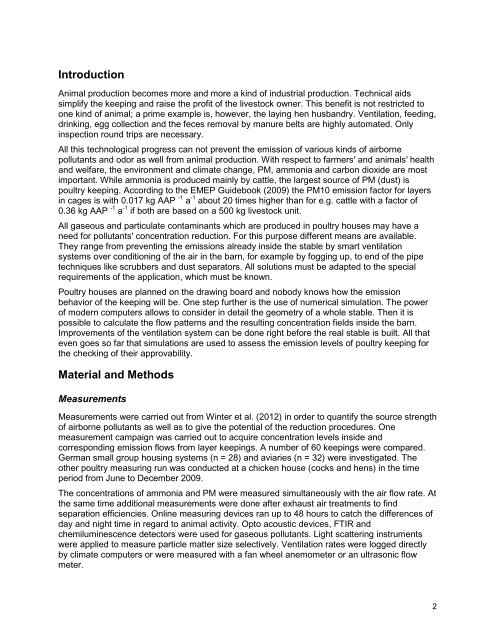Paper No: 200000 - International Conference of Agricultural ...
Paper No: 200000 - International Conference of Agricultural ...
Paper No: 200000 - International Conference of Agricultural ...
Create successful ePaper yourself
Turn your PDF publications into a flip-book with our unique Google optimized e-Paper software.
IntroductionAnimal production becomes more and more a kind <strong>of</strong> industrial production. Technical aidssimplify the keeping and raise the pr<strong>of</strong>it <strong>of</strong> the livestock owner. This benefit is not restricted toone kind <strong>of</strong> animal; a prime example is, however, the laying hen husbandry. Ventilation, feeding,drinking, egg collection and the feces removal by manure belts are highly automated. Onlyinspection round trips are necessary.All this technological progress can not prevent the emission <strong>of</strong> various kinds <strong>of</strong> airbornepollutants and odor as well from animal production. With respect to farmers′ and animals′ healthand welfare, the environment and climate change, PM, ammonia and carbon dioxide are mostimportant. While ammonia is produced mainly by cattle, the largest source <strong>of</strong> PM (dust) ispoultry keeping. According to the EMEP Guidebook (2009) the PM10 emission factor for layersin cages is with 0.017 kg AAP -1 a -1 about 20 times higher than for e.g. cattle with a factor <strong>of</strong>0.36 kg AAP -1 a -1 if both are based on a 500 kg livestock unit.All gaseous and particulate contaminants which are produced in poultry houses may have aneed for pollutants′ concentration reduction. For this purpose different means are available.They range from preventing the emissions already inside the stable by smart ventilationsystems over conditioning <strong>of</strong> the air in the barn, for example by fogging up, to end <strong>of</strong> the pipetechniques like scrubbers and dust separators. All solutions must be adapted to the specialrequirements <strong>of</strong> the application, which must be known.Poultry houses are planned on the drawing board and nobody knows how the emissionbehavior <strong>of</strong> the keeping will be. One step further is the use <strong>of</strong> numerical simulation. The power<strong>of</strong> modern computers allows to consider in detail the geometry <strong>of</strong> a whole stable. Then it ispossible to calculate the flow patterns and the resulting concentration fields inside the barn.Improvements <strong>of</strong> the ventilation system can be done right before the real stable is built. All thateven goes so far that simulations are used to assess the emission levels <strong>of</strong> poultry keeping forthe checking <strong>of</strong> their approvability.Material and MethodsMeasurementsMeasurements were carried out from Winter et al. (2012) in order to quantify the source strength<strong>of</strong> airborne pollutants as well as to give the potential <strong>of</strong> the reduction procedures. Onemeasurement campaign was carried out to acquire concentration levels inside andcorresponding emission flows from layer keepings. A number <strong>of</strong> 60 keepings were compared.German small group housing systems (n = 28) and aviaries (n = 32) were investigated. Theother poultry measuring run was conducted at a chicken house (cocks and hens) in the timeperiod from June to December 2009.The concentrations <strong>of</strong> ammonia and PM were measured simultaneously with the air flow rate. Atthe same time additional measurements were done after exhaust air treatments to findseparation efficiencies. Online measuring devices ran up to 48 hours to catch the differences <strong>of</strong>day and night time in regard to animal activity. Opto acoustic devices, FTIR andchemiluminescence detectors were used for gaseous pollutants. Light scattering instrumentswere applied to measure particle matter size selectively. Ventilation rates were logged directlyby climate computers or were measured with a fan wheel anemometer or an ultrasonic flowmeter.2
















